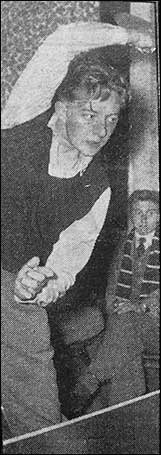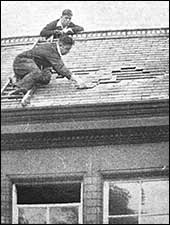The Rushden Echo and Argus, 9th October, 1953, transcribed by Jim Hollis
Youth Building in Disrepair
Rain comes into the Y.M.C.A.
 |
Aggression is the key-note here; a Y.M.C.A. member has just delivered an attacking forehand drive during a favourite session of table tennis.
|
Financial “cramp” and the imperative need for a new roof and flooring costing several hundreds of pounds, is threatening Rushden’s most popular rendezvous for teenagers – the Y.M.C.A. premises on The Green.
|
A hole in the roof of Rushden’s Y.M.C.A. centre is just one pointer to the general dilapidation of the premises which now confronts the members.
|
 |
|
Finances are low and the potential cost of a new roof and flooring alone runs into several hundreds.
|
|
Rain dripping in through the roof has made the 250 members – the boys outnumber the girls by eight to one incidentally – literally sit up and examine their finances with alacrity. The picture is not reassuring.
There has been a sliding balance ever since the end of the war. The reason is not hard to find: Without a fulltime secretary the centre is not entitled to a Headquarter’s grant; subscriptions range only from 3s. – 6s. for the boys and 2s. 6d. – 5s. for the girls, a year, hardly the cost of light and heat. True, they pay a little extra for the games they play, but by and large the centre has to rely upon the generosity of its vice-presidents.
Apart from the rental of the factory beneath the premises the Centre has existed almost entirely on the profits accumulated during the war years by the Women’s Auxiliary.
During those years the women served hot suppers every night to British and overseas troops visiting the premises and the nett result was the installation of shower baths and a comfortable bank balance.
Bazaar helps
Since then, however, there has been nothing on the credit side – except perhaps the annual Christmas bazaar in which the tradesmen of the town co-operate by contributing their goods for sale.
When Mr. Philip Mould took over as part-time secretary 18 months ago, he viewed the dilapidations with a wary eye. Apart from a little redecoration about four years ago there has probably been nothing structurally done to the Centre since it was opened 26 years ago.
“Last year we had the roof patched up and the contractor said he was afraid he could not do it again as the slates had had to be cemented in. Last week another 900 tiles had to be re-nailed – and that was on only part of the roof. It’s now started to rain through,” he said.
The cost of a new roof will be about £200 and it must be done this winter. Two new floors – both in the top and billiards room – are required. They have been re-patched and renovated until they are now beyond further repair.
Well attended
Immediate reaction has been to hold a jumble sale; organise a mile-of-pennies between the members and abandon the television fund which had already reached £40. But it will take many more such efforts to raise the necessary money.
It is now that the centre gets its best attendances of the year. It is open every night between 6.30 and 10 p.m., with the exception of Sundays, but throughout the winter you will find about 100 youngsters there nightly. Members come in not only from Rushden and Higham Ferrers, but the outlying villages of Souldrop, Stanwick and Irthlingborough.
Two more potentials knocked on the door the evening the “Echo and Argus” was there – a pair of under 18s from Irthlingborough – Brian Stevenson and Brian White. The centre is, of course, open to troops at all times and there are quite a few American regulars who have started a craze for draughts among the “locals.”
Many games
The two Brians were invited to make a preliminary inspection before completing their enrolment forms. They discovered a football practice in session under the guidance of Mr. Albert Knight; table tennis, billiards, snooker and darts.
In the canteen Valerie Lovell and Pam Jeffrey served cups of tea and coffee with snacks, chocolates and cigarettes. All the girls who are members take it in turns to staff the canteen.
They learned too that the Rushden Y.M.C.A. has first class football and cricket teams; a very popular music club on Wednesday nights, conducted by Mr. Don Wildman; a whist drive every month and a drama group which Miss M. Orchard coaches at her own home. And the president, Mr. J. H. Willmott, free from farming commitments, looks in most winter evenings.
In short the Y.M.C.A. offers the best possible facilities in the best possible environment for young people. Its work, however, is so quiet and unassuming as to go unnoticed by many. We focus the limelight on it this week that they may count on your support.
|